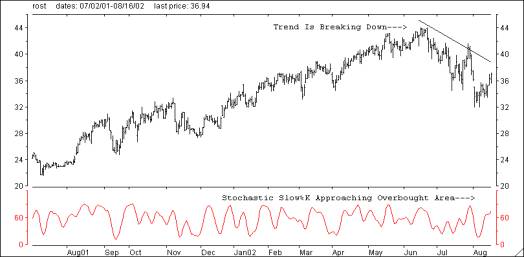 The Right Stock At The Right Time®
The Right Stock At The Right Time® The Right Stock At The Right Time® The Right Stock At The Right Time® |
|
||
|
"SHORT" Is Not A Four Letter Word
Trees don't grow to the sky, what goes up must come down, if you inhale you must exhale and stocks don't go up forever. So what is one to do when the big bad bear takes hold of the market? Short 'em baby. Contrary to popular belief, shorting stocks is not un-American nor, if done properly any more risky than buying stocks. Plus, when you get it right, a good short can fall much faster than it takes for a typical long position to rise.
The following procedure should be adhered to when developing a successful short-sale strategy.
1) Market Trend: Seventy percent of stocks will typically follow the market's trend. Market Edge's Cyclical Trend Index (CTI) which is the core of our 'Market Posture' has a track record dating back to 1974 of forecasting the market's intermediate term direction as measured by the DJIA with better than 80% accuracy. Therefore, in order to have the odds on your side when shorting stocks, it is important that the 'Market Posture' be regarded as bearish.
2) Identifying Short-Sale Candidates: The temptation when looking for short sale candidates is to go after the stocks that have been the recent high flyers. This can be a very risky proposition. There is usually a good reason why a stock has been an outstanding performer. So even if the market tanks, the likelihood of the high flyer crashing to the ground are slim. If you must chase a high flyer, wait for it to break down before initiating a short position. You will not get the full ride but once they break, there is usually plenty of room on the downside.
A more conservative approach is to find stocks that have been market laggards during the previous bull phase. The logic is simple. If a stock can't perform during the good times, what will it do when things get rough? Also, if the assessment of the market's trend is wrong, the likelihood of getting hurt is greatly reduced. Market Edge's Second Opinion classifies stocks as Long (buy), Neutral or Avoid. Depending on the amount of recent downside momentum, a stock with an Avoid Opinion may also be regarded as a short-sale candidate.
Market Edge isolates those stocks that meet the above criteria. To retrieve these stocks on a daily basis, click on Analysis Tools on the Market Edge tool bar, followed by Stock Analysis and then on Best Shorts. Also, the Market Edge Prime Ideas section contains a list of short sale candidates, which are former momentum stocks that have broken down.
3) Timing The Trade: Once a short sale candidate has been identified, the next step is to time the entry point. This
is best accomplished by waiting for an overbought condition to develop based on the stochastic oscillator, a technical indicator with values that range from 0 to 100. When the stochastic oscillator is between 20-80, a neutral condition is in force. Readings above 80 denote an overbought condition.
 The easiest way to identify overbought stocks with Market Edge is to make a list in Stock Watch that contains your short sale candidates. On a daily basis, click on Best Shorts under the Situations drop down. The stocks in this list will satisfy all of the criteria described above. 4) Exiting The Position: Whenever any of the following events occur, the short sale should be closed: The market trend reverses to bullish, the stock violates it's buy stop, a target is reached or, for a short-term trade, the stochastic indicator falls below 20 indicating an oversold condition. There are several prerequisites that you need to be familiar with when shorting stocks. 1) Permission To Short: Before you can short a stock you must get permission from your brokerage firm. If your brokerage firm doesn't have any stock, they will have to borrow it from another firm so they can deliver it to the buyer. If there isn't any stock to borrow, you can't short the stock. If you can't borrow any shares, you don't want to short it anyway. This indicates a situation where there is a large short position in the stock and increases the odds that a short squeeze could develop. 2) Uptick Rule: A SEC rule that restricts when a short sale may be executed. This rule is intended to prevent destabilizing the price of a stock when the market price is falling. A short sale can be made only when one of the following situations exists: 1) The sale occurs at a higher price than the last trade or 2) there is no change in the last trade while the previous trade took place at a higher price than the price that preceded it. 3) Margin Requirements: Usually margin requirements for short sales are the same as a long position purchased in a margin account, 50%. Unlike a margin account, there is no interest charged and in some cases you may receive an interest credit. If you short 1000 shares of a $20 dollar stock, you will have to put up $10,000 in either cash or bonds and execute the trade in a specified short-sale account. In short, selling stocks short is not for everyone. However, during extended bear markets it can be a very profitable strategy for aggressive traders.
|